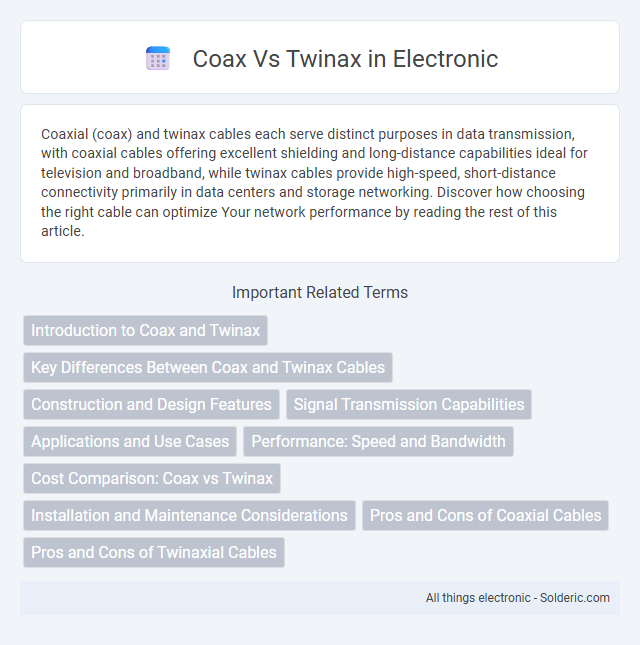Coaxial (coax) and twinax cables each serve distinct purposes in data transmission, with coaxial cables offering excellent shielding and long-distance capabilities ideal for television and broadband, while twinax cables provide high-speed, short-distance connectivity primarily in data centers and storage networking. Discover how choosing the right cable can optimize Your network performance by reading the rest of this article.
Comparison Table
| Feature | Coaxial Cable (Coax) | Twinaxial Cable (Twinax) |
|---|---|---|
| Structure | Single central conductor with shielding | Two central conductors twisted together with shielding |
| Signal Type | Analog and digital signals | Primarily digital signals |
| Use Cases | Television, internet, CCTV, broadband | High-speed data transmission, data centers, storage area networks (SANs) |
| Data Rate | Up to 10 Gbps depending on type | Up to 32 Gbps and beyond |
| Distance | Up to 500 meters (varies by type) | Short range, typically under 15 meters |
| Impedance | Typically 50 or 75 ohms | Typically 85 ohms |
| Cost | Generally lower cost | Higher cost due to specialized use |
| Connector Types | F-type, BNC, N-type | Mini-SAS, SFP+, and proprietary connectors |
Introduction to Coax and Twinax
Coaxial cable (Coax) and Twinaxial cable (Twinax) are types of electrical cables used for data transmission, with Coax featuring a single central conductor surrounded by insulation and shielding, while Twinax consists of two conductors twisted together and shielded. Coax is commonly used in cable television and broadband internet applications due to its ability to support high-frequency signals over long distances. Your choice between Coax and Twinax depends on the specific requirements for signal integrity, distance, and application environment.
Key Differences Between Coax and Twinax Cables
Coax cables feature a single central conductor surrounded by insulation and a metallic shield, enabling high-frequency signal transmission with strong resistance to electromagnetic interference. Twinax cables consist of two closely spaced conductors within a single shield, offering improved noise rejection and better performance for differential signaling in short-distance, high-speed data applications. While coaxial cables are commonly used in cable TV and broadband internet, twinax cables are preferred for high-speed connections in data centers and server environments due to their enhanced signal integrity.
Construction and Design Features
Coaxial cables consist of a single central conductor surrounded by a dielectric insulator, a metallic shield, and an outer jacket, offering superior protection against electromagnetic interference. Twinax cables feature two internal conductors twisted together and shielded by a single metallic braid or foil, providing enhanced noise rejection and improved signal integrity over short distances. The coax design suits high-frequency signals with a characteristic impedance typically of 50 or 75 ohms, whereas twinax cables often have a characteristic impedance around 100 ohms, optimized for balanced differential signaling.
Signal Transmission Capabilities
Coax cables deliver reliable signal transmission over longer distances with minimal interference, making them ideal for broadband and video applications. Twinax cables excel in high-speed data transfer within shorter ranges, commonly used in data centers and server environments due to their superior noise immunity and reduced latency. Your choice between coax and twinax should consider the required bandwidth and distance to optimize signal integrity and performance.
Applications and Use Cases
Coaxial cables excel in applications requiring high-frequency signal transmission such as cable television, internet, and radio communications, ensuring reliable performance over long distances. Twinax cables are preferred in data centers and server environments for short-range, high-speed connections within storage area networks (SANs) and Ethernet links, offering enhanced noise immunity and lower latency. Your choice depends on whether your setup prioritizes long-distance signal integrity with coax or high-speed, low-latency connectivity with twinax.
Performance: Speed and Bandwidth
Coaxial cables typically support speeds up to 10 Gbps with bandwidths around 1 GHz, making them suitable for traditional broadband and cable TV signals. Twinax cables offer higher performance with data rates reaching 40 Gbps and bandwidths exceeding 10 GHz, ideal for short-range, high-speed data transfers in data centers. Choosing Twinax enhances your network speed and bandwidth capabilities significantly compared to coaxial cables.
Cost Comparison: Coax vs Twinax
Coaxial cables generally cost less upfront compared to twinax cables, making them a more budget-friendly option for basic networking needs. Twinax cables, however, offer higher performance and lower latency, which can justify their higher price in data center applications. Your choice between coax and twinax should balance initial cost with long-term benefits such as speed and reliability.
Installation and Maintenance Considerations
Coaxial cables offer simpler installation with flexible connectors and widespread compatibility, making them ideal for many standard networking environments. Twinax cables require more precise handling due to their rigid structure and specialized connectors, which can increase installation time and the need for skilled technicians. Your maintenance strategy should weigh the durability and signal integrity of twinax against the ease of troubleshooting and replacement associated with coaxial systems.
Pros and Cons of Coaxial Cables
Coaxial cables offer high bandwidth and efficient shielding against electromagnetic interference, making them ideal for cable TV and broadband internet connections. Their durability and resistance to signal degradation over long distances provide reliable performance, but coax cables tend to be thicker and less flexible compared to Twinax cables, which can complicate installation in tight spaces. Cost-effectiveness is another advantage, though they generally lack the speed and noise immunity required for high-performance data center applications compared to Twinax cables.
Pros and Cons of Twinaxial Cables
Twinaxial cables offer high-speed data transmission with enhanced noise immunity, making them ideal for short-distance applications such as data centers and server connections. Their compact, flexible design supports easy installation but may experience signal degradation over longer distances compared to coaxial cables. Cost-effectiveness and superior performance in differential signaling environments highlight Twinax's advantages, while limited reach restricts their use in extensive network setups.
Coax vs Twinax Infographic

 solderic.com
solderic.com